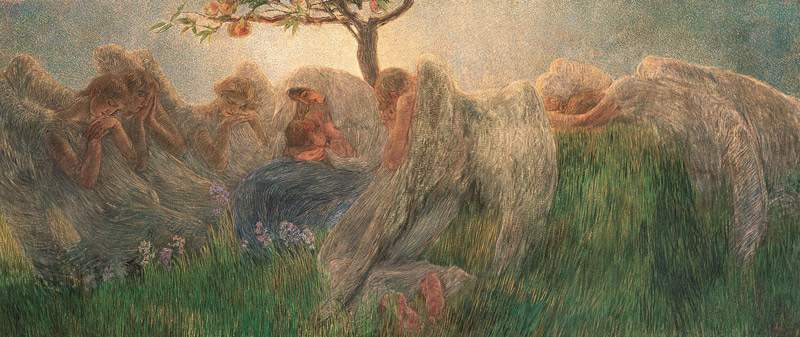In Novara a major exhibition on pointillism with all the protagonists, from Morbelli to Pellizza da Volpedo
From November 23, 2019 to April 5, 2020, the Visconteo Sforzesco Castle in Novara is hosting the exhibition Divisionism. The Revolution of Light, which has an ambitious goal: “to be the most important exhibition dedicated to Divisionism realized in recent years,” as the presentation states. Curated by Annie-Paule Quinsac, who has dedicated herself to the study of Divisionist art since the 1960s (in particular, she is an expert on artists such as Giovanni Segantini, Carlo Fornara and Vittore Grubicy de Dragon), it intends to trace the history of Divisionism, and in particular that of Lombardy-Piedmont, such that the artists’ relationships with the territory determined the choices and the overall cut.
Divisionism was born in Milan, on the same premise as pointillisme born in France, but without any direct influence. It moves from the idea that the study of optical treatises, which revolutionized the concept of color, should determine the technique of the modern painter. It developed in northern Italy, thanks mainly to the support of Vittore Grubicy de Dragon, an art dealer, critic, publicist and himself a painter, who with his brother Alberto ran an art gallery in Milan starting in 1876. It was Vittore who spread among the painters in his stable the principle of replacing the chemical mixture of colors traditionally obtained on the palette with a direct approach to the juxtaposition of complementary tones on the canvas. From a chemical datum, color becomes an optical phenomenon, and at the proper distance the viewer’s eye can recompose the detached brushstrokes into a tonal synthesis, perceiving a greater luminosity in the painting. Soon Divisionism from Milan and Lombardy spread to Piedmont: the divided brushstroke was destined to become a privileged tool in the translation of a poetics of nature or a focus on social issues. Only Gaetano Previati, irreducibly anti-realist from his beginnings, elaboratesa symbolist vision that springs from myth, a visionary interpretation of history or Christian iconography, at the antipodes of Segantini’s always tied to the naturalist root of a panic perception of high altitude.
The exhibition consists of eight thematic sections: the first delves into the Grubicy Gallery’s artists, with works by Tranquillo Cremona, Daniele Ranzoni, Giuseppe Pellizza da Volpedo, Angelo Morbelli, Gaetano Previati, Emilio Longoni, Giovanni Segantini, and, of course, Vittore Grubicy himself. The second section is dedicated to the I Triennale di Brera, which was held in Milan in 1891, the year to which the “official” birth of the movement is usually traced: the public will be able to admire here Previati’s grandiose Maternity, created between 1890 and 1891 (given the exceptional nature of the loan, it has been placed in a room where it can be accessed free of charge to admire it). Works by Segantini, Morbelli, Pellizza, Longoni, Grubicy, and Sottocornola complete the section. The third section, on the other hand, is dedicated to the triumph of pointillism and its main interpreters ( Plinio Nomellini and Carlo Fornara are also added to those mentioned above), while the fourth will present an in-depth study entirely dedicated to Pellizza da Volpedo, with five of his works including the masterpiece On the Barn, conceived in the summer of 1892. The fifth section offers a further thematic investigation of snow (protagonists include Segantini, Fornara, Morbelli and others), while the sixth introduces a focus on Gaetano Previati. The seventh room is also dedicated to a single protagonist, namely Segantini, of whom seven drawings are exhibited. Finally, the last room presents the developments of pointillism in the first decades of the 20th century.
The exhibition is accompanied by a scholarly catalog with an essay by the curator accompanied by biographical sketches of the artists, with critical entries of the individual works entrusted to the relevant specialists and bibliographical and exhibition apparatus. The exhibition is promoted and organized by the Municipality of Novara, the Visconti Castle Foundation and the METS Percorsi d’arte Association, in collaboration with ATL of the Province of Novara, with the patronage of the European Commission, the Piedmont Region and the Province of Novara, and with the support of Banco BPM (Main Sponsor), Fondazione CRT and Esseco s.r.l. For all info you can visit the Novara Castle website.
Pictured: Gaetano Previati, Maternity (1890-91; oil on canvas, 175.5 x 412 cm; Banco BPM Collection)
 |
| In Novara a major exhibition on pointillism with all the protagonists, from Morbelli to Pellizza da Volpedo |
Warning: the translation into English of the original Italian article was created using automatic tools. We undertake to review all articles, but we do not guarantee the total absence of inaccuracies in the translation due to the program. You can find the original by clicking on the ITA button. If you find any mistake,please contact us.




























